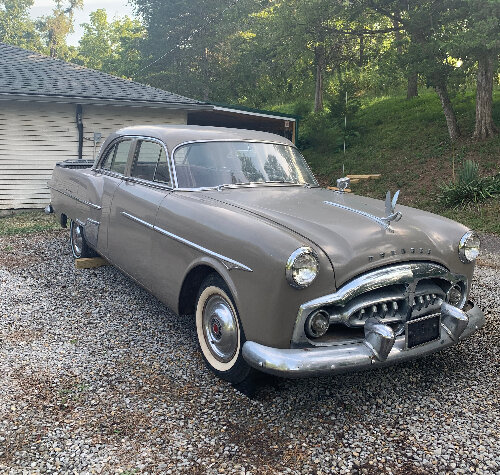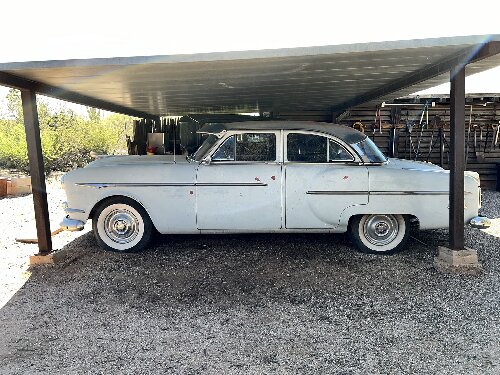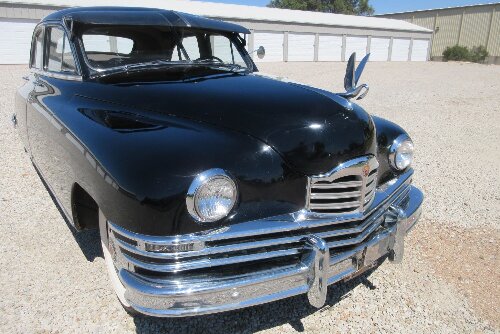|
Re: V-8 engine design flaws
|
||||
|---|---|---|---|---|
|
Webmaster
|
You have to remember that the Packard V8s were only in production 2 years, and it was a relative small production run compared to even one engine from any of the Big Three for a single year. I think almost every new engine has a period where things are learned from based on customer use, and wear and tear.
Packard just wasn't able to hang in there long enough to discover and improve those things.
Posted on: 2010/1/23 17:41
|
|||
|
-BigKev
1954 Packard Clipper Deluxe Touring Sedan -> Registry | Project Blog 1937 Packard 115-C Convertible Coupe -> Registry | Project Blog |
||||
|
||||
|
Re: V-8 engine design flaws
|
||||
|---|---|---|---|---|
|
Home away from home

|
First, compare the Packard V-8 to its contemporaries. In that comparison, it comes off rather well. Compared to later evolved or new designs, not so much.
Besides the oil pump, I think the biggest drawback in retrospect from a performance point of view are the siamesed center exhaust ports. Because of the head bolts in the way, there is no way to increase that port size much. A change of valve layout would have been necessary ala Pontiac Ram Air V. There are other limitations that have been pointed out before and are too numerous to relist here, but in normal driving only the oil pump has proven to be a long term "flaw." Packard could have easily corrected that later on. Craig
Posted on: 2010/1/23 17:47
|
|||
|
Nuke them from orbit, it's the only way to be sure! Ellen Ripley "Aliens"
Time flies like an arrow. Frui |
||||
|
||||
|
Re: V-8 engine design flaws
|
||||
|---|---|---|---|---|
|
Forum Ambassador

|
You'll probably get a lot of divergent opinions on this, I'll give mine based on my 56 V8 and experiences of other local owners.
The Torsion Level was remarkably trouble free except for moisture/corrosion on the unprotected electrical components under the car. Pretty simple to repair. The 56 version was improved. Twin Ultramatic was probably about as good as any of it's contemporaries (early PowerFlite was no bargain) as long as driven sensibly - it did not have much tolerance for a heavy diet of jack-rabbit starts. The 56 units were considerably improved. I believe GM built more 265 Chevy V8s in their first 3 weeks than Packard built theirs in 2 years, and they (Chevy) had some teething issues too. Experiences vary but it seems pretty obvious that the oil pump could have been better designed, though it's easy enough to remedy if needed. My own v8 has 91,000 miles, never worked on as far as I can tell, original oil pump, bearings with acceptable clearances, quiet lifters, and great oil pressure. Yet there is plenty of evidence to say that problems can begin to give symptoms as early as 40,000 miles on other cars. Certainly individual owner's experiences vary considerably.
Posted on: 2010/1/23 18:18
|
|||
|
||||
|
Re: V-8 engine design flaws
|
||||
|---|---|---|---|---|
|
Home away from home
|
Agree with all that, but given their legendary expertise it seems odd that something so basic as inadequate oiling would turn out to be a problem. The complex Chrysler Double Rocker 331 V8 of 1951 had no real weakness or teething problems whatever once in production (I've had a number of what has colloquially later become known as the "hemi", Chrysler themselves never called it by that name at the time) so I'd put it down to perhaps the small size of the engineering staff and lack of adequate capital for the V8's development and testing on the part of Packard, and, as mentioned, the small number of engines produced. Perhaps in retrospect it's easy to now really understand Packard's apparently well founded reluctance to move away from their well proven straight 8s for as long as they did.
What modifications are considered mandatory for durability at this point? - specifically, is the Olds pump substitution required, or merely desirable... 91K on an original engine is not high mileage these days, or even then. There's a '56 Cad with over one million miles supposedly. Richard Langworth has stated rod bearings are also suspect in Packard Buyers Guide, perhaps as a result of the oil pump issue?. Also valve seals have been mentioned by some.
Posted on: 2010/1/23 20:36
|
|||
|
||||
|
Re: V-8 engine design flaws
|
||||
|---|---|---|---|---|
|
Forum Ambassador

|
My somewhat limited experience says the first bearings to show problems are mains, often #3 first. I've not heard of rod bearing problems.
I'd say the minimum mandatory change is to have the oil pump rebuilt by someone who will install a shaft sleeve bushing. Some would say that replacing the vacuum pump with a solid lower plate and support bearing is mandatory, but I'd say it's suggested but not essential, but lack of support at the shaft bottom is a design weakness. What is also essential for 55 and early 56 is to change the front camshaft thrust plate (forget the right name for it) with the later replacement part, or buy the repro from Jack Vines. This was a running change, as was changes to the oil holes int he rocker shafts. Any engine of the 50s that claims a million miles with nothing sounds highly suspect to me. At the very least a valve grind or two must have occurred, and I'd be suprised if there wasn't a bit more.
Posted on: 2010/1/23 20:52
|
|||
|
||||
|
Re: V-8 engine design flaws
|
||||
|---|---|---|---|---|
|
Forum Ambassador

|
My dad's Exec had nearly 75K on the clock when he parked it in a field back in 1963 - due to non-engine issues. Among other things, the Twin Ultra. had recently been overhauled by an independent shop (as the Packard dealer servicing network had effectively evaporated around these parts), and it was starting to act up again.
The engine in that Exec had never been opened up for anything other than an oil change and never had any lifter noise. My dad even declined a free set of chrome valve covers offered by the dealer - as thanks for use of his Exec on a demo drive that helped close a deal - because he didn't want to open the engine unnecessarily. WRT to sludge in the oil pan, there was one thing my dad taught me about doing an oil change on these V8s. He would form a loop out of a piece of heavy wire (a cheap coat hanger would do), insert it through the drain hole, and sweep the bottom of the pan for any sludge. He would also tickle the pickup screen to make sure it wasn't stuck - up or down. These days, removing and cleaning oil pan that's been in place for 50+ years is highly recommended - on any car. I've never had time to fetch the engine from that old Exec and perform an autopsy, but I strongly suspect it had all the latest running production changes. Several previous changes and the redesigned oil pump are documented - check the "Engine" section of our 55-56 Service Index. However, it's impossible to say what other oiling-related changes might have been made that were never disclosed to the dealers. Meanwhile, in researching content for the 48-50 Service Index, I found an article that raised an eyebrow in SC Vol. 21, No. 2 of January 15, 1947 - see page 6. Seems that Packard had run into this sort of problem previously, but rather than a problem rooted in inadequate pump design, this suggests some unanticipated bearing wear - where they just threw more oil at the problem. I wouldn't rush to any decision about the oil pump in a recently-acquired car until determining it's present level of performance. Keep in mind that low oil pressure may not be solely the fault of the pump. I never put much faith in castrating the V8 oil pump of its vacuum pump assembly - a notion first published by PI in 1975. The 56J Golden Hawk used the same oil pump, but without the vac pump, yet Studebaker's Service Letter No. 936 of May 22, 1956 that echoes Packard's STB 56T-20 of May 3, 1956, which this site has on file. I haven't gotten to the point of rebuilding any of my V8s yet, but while I do have a Melling pump, pickup, and adapter, I would only use it if the original pump was beyond repair and and a rebuildable core was not available. Given what I've heard from many other V8 owners who experienced lifter noise, and assuming everything else is to proper spec, my personal preferences are to: - retain the OE vacuum pump - install an upper bushing in the driving shaft bore of the oil pump body - carve an internal groove (as member PackardV8 once showed us in the small-block Chevy pump) to supply that bore - now bushed - with a bit of oil - true or replace the driving shaft as needed, for any corresponding wear - install the late design camshaft thrust plate AND spacer In the event that a pump in any of my Packard V8s turns out to be the early design, with open relief valve port, then I'll probably install the sump tube, per the aforementioned STB - just to be safe. I may also try shimming the relief valve spring for a little bit more pressure - if needed. People have been doing that for decades with the old SBC.
Posted on: 2010/1/23 21:08
|
|||
|
||||
|
Re: V-8 engine design flaws
|
||||
|---|---|---|---|---|
|
Home away from home

|
'Design flaws' of the Packard V8 engine can be well accounted for by reading the STB's and SC's. HOWEVER, do not take the STB's and SC's suggested remedies as reliable information. The only thing reliable about them is statement of the problem/symptom.
Some of the mods we discuss are available only NOW and were not available 50 nor even 40 years ago. e.g. the Olds pump conversion. The Olds pump we use did not exist prior to ca. 1972. Availability of parts of OEM spec are no longer available today or so rare. SO we are almost forced to other alternatives if for no other reason than cost. When comparing the Packard V8 to other engines of it's time we must keep in mind that the Packard engine was supposed to be a HIGH DOLLAR LUXURY CAR ENGINE!!!! The Packards were NOT priced like some farmers hay wagon with a 216 Blue Flame engine or some Rita the Riveter's 55 chevy or ford or plymouth with a small V8.
Posted on: 2010/1/23 23:01
|
|||
|
VAPOR LOCK demystified: See paragraph SEVEN of PMCC documentaion as listed in post #11 of the following thread:f
https://packardinfo.com/xoops/html/modules/newbb/viewtopic.php?topic_id=7245 |
||||
|
||||
|
Re: V-8 engine design flaws
|
||||
|---|---|---|---|---|
|
Home away from home

|
Some of the worst vehicles ever made were designed and produced in the 70's and early 80's, regardless of the Marque. The entire vehicles were junk. That is the main reason foreign imports began to gain traction with the consumer. Compared to most of the junk produced in that era, the Packards produced in the 50's were pretty near perfect.
Posted on: 2010/1/24 13:46
|
|||
|
||||
|
Re: V-8 engine design flaws
|
||||
|---|---|---|---|---|
|
Home away from home

|
Most new designs have teething troubles. The Chev V8 as initially produced had a design flaw that stopped oil from circulating if the distributor was put in wrong. They solved this by changing from a flat spot on the distributor to a groove. But a few engines suffered lubrication problems first.
The first Chrysler and Studebaker V8s had problems with premature cam and lifter wear. They were not used to dealing with the heavy cam loads of OHV engines. Chrysler changed the design of their lifters twice, Studebaker changed the material they used. Ford's Y block also had problems with the lubrication system either leaking out the oil or clogging up and not oiling the valves at all. The list could be extended indefinitely. The point is that it is practically impossible to design something as complicated as a car engine and have every part perfect first try. It is normal for bugs to show up, the best car makers correct these faults quickly and if necessary recall the defective cars and fix them before the owner has trouble. Packards were far from the worst. Evidently their oil pumps had a flaw that caused problems in a few cars. They moved quickly to redesign the pump and correct the problem. Don't make too much out of this.
Posted on: 2010/1/24 19:59
|
|||
|
||||








